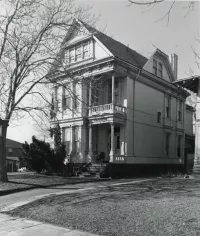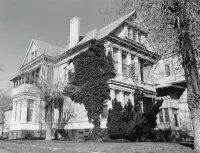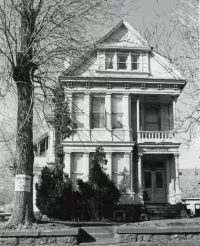Share what you know,
and discover more.
Share what you know,
and discover more.
May 30, 1975

-

- Charmaine Bantugan
National Register of Historic Places - Simon Bamberger House
Statement of Significant: The home derives its primary significance from its original owner, Simon Bamberger, one of the most significant figures in Utah political history. It was his election as governor in 1916 which served to bridge the chasm between Mormons and non-Mormons which had cut through Utah politics for nearly a half century. Born February 27, 1845, in the small village of Eberstadt, Hesse-Darmstadt between Frankfurt and Heidelberg, Germany, Bamberger journied to the United States in 1859 at the age of fourteen. He worked in his brother Herman's small clothing store in Wilmington, Ohio, and later moved with his brother to St. Louis where they greatly enlarged their business. Simon came west with the Union Pacific Rail- road managing a company store and aiding with the erection of tents and shacks of the "Hell on Wheels" construction camps. Because of his honesty and sobriety, gamblers, dancehall girls and laborers, not trusting their own weaknesses, would ask Simon to hold checks and money for them. By early 1869 he had arrived in Ogden, Utah, and a short time later moved to Salt Lake City to begin a prosperous business career. In partnership with a fellow Jew, Briner Cohen, Simon purchased the Delmonico Hotel, renamed it "the White House" and catered to a clientele of mining men. From his contact with Utah's mining element, Bamberger invested in several Utah and Nevada ventures which proved financially successful. His other business enterprises included the construction of the Bamberger Railroad, originally named "The Great Salt Lake and Hot Springs Railway" which was started in 1892 and by 1908 reached Ogden. The railroad operated until 1952. The Bamberger Railroad served another important enterprise, the summer resort of Lagoon which was established by Bamberger after his railroad reached Farmington in 1895. The resort is still in operation as Utah's most popular amusement park. Bamberger's political career began in 1898 when he was selected to fill a vacant position on the Salt Lake City Board of Education. In 1902 Bamberger was elected to the State Senate as only one of three Democrats in the entire Utah Senate. He served only one term. In 1915 he announced his availability for nomination to the U.S. Senate and after some consideration decided instead to seek the position of governor. In the 1916 election, Bamberger had great support from the Mormon Church. His personal abstention from alcohol and tobacco and support of prohibition was also enhanced by the report from Joseph L. Rawlins, Democratic Senator from Utah (1897-1903) that Bamberger had strongly protested the movement to disfranchise certain Mormons and escheat church property. Bamberger's popularity with the Mormon element is humorously expressed in the following which has become part of Utah's folklore: "On a visit to Sanpete County, Bamberger alighted from the train and was met by a local delegation headed by a tall, robust Norwegian with a flowing beard. In contrast, Bamberger, who was short and stubby, heard this towering Norwegian greet him with a menacing threat: 'You might just as well go right back were you come from. If you think we lat any damn Yentile speak in our meeting house, you’re mistaken!' Bamberger looked up into the face of the determined looking leader and slowly replied: 'As a Jew, I have been called many a bad name, but this is the first time in my life that I have been called a Dann Gentile!' Instantly the menacing attitude of the leader of the committee relaxed, and, throwing his arm around Bamberger's shoulders, he exultingly exclaimed: 'You a Yew, an Israelite! Hear him, men, he's not a Yentile; he's a Yew, an Israelite!' and then to Bamberger: 'welcome, my friend; welcome, our next Governor."" The campaign was dirtied by anti-Semitic overtones when a caricature of Bamberger accentuating his nose and ears in an obvious effort to call attention to his Jewish heritage was circulated allegedly by the Republican State Committee. During his administration a Public Utilities Commission was established and a Workmen's Compensation Act was passed. Social and educational programs were developed and a state-wide prohibition law was passed. Politically Bamberger served as a worthy example to the State's majority population of Mormons that a non-church member could effectively serve and promote their interests. As a member of the Congregation B'nai Israel, Simon Bamberger was active in his own church affairs, serving as president of the Congregation for several years. He was instrumental in promoting the construction of the B'nai Israel Synagogue which was completed in 1891. He also supported the Jewish Agricultural Colony at Clarion in Sanpete County which was founded in 1911 when a group of eastern Jews, tired of city life and anxious to return to the soil, made their exodus to the Mormon Zion. Bamberger interceded several times to help avert the inevitable financial failure of the colony. Simon Bamberger died in 1926. His home serves as an excellent reminder of his personal accomplishments and role in Utah history.
National Register of Historic Places - Simon Bamberger House
Statement of Significant: The home derives its primary significance from its original owner, Simon Bamberger, one of the most significant figures in Utah political history. It was his election as governor in 1916 which served to bridge the chasm between Mormons and non-Mormons which had cut through Utah politics for nearly a half century. Born February 27, 1845, in the small village of Eberstadt, Hesse-Darmstadt between Frankfurt and Heidelberg, Germany, Bamberger journied to the United States in 1859 at the age of fourteen. He worked in his brother Herman's small clothing store in Wilmington, Ohio, and later moved with his brother to St. Louis where they greatly enlarged their business. Simon came west with the Union Pacific Rail- road managing a company store and aiding with the erection of tents and shacks of the "Hell on Wheels" construction camps. Because of his honesty and sobriety, gamblers, dancehall girls and laborers, not trusting their own weaknesses, would ask Simon to hold checks and money for them. By early 1869 he had arrived in Ogden, Utah, and a short time later moved to Salt Lake City to begin a prosperous business career. In partnership with a fellow Jew, Briner Cohen, Simon purchased the Delmonico Hotel, renamed it "the White House" and catered to a clientele of mining men. From his contact with Utah's mining element, Bamberger invested in several Utah and Nevada ventures which proved financially successful. His other business enterprises included the construction of the Bamberger Railroad, originally named "The Great Salt Lake and Hot Springs Railway" which was started in 1892 and by 1908 reached Ogden. The railroad operated until 1952. The Bamberger Railroad served another important enterprise, the summer resort of Lagoon which was established by Bamberger after his railroad reached Farmington in 1895. The resort is still in operation as Utah's most popular amusement park. Bamberger's political career began in 1898 when he was selected to fill a vacant position on the Salt Lake City Board of Education. In 1902 Bamberger was elected to the State Senate as only one of three Democrats in the entire Utah Senate. He served only one term. In 1915 he announced his availability for nomination to the U.S. Senate and after some consideration decided instead to seek the position of governor. In the 1916 election, Bamberger had great support from the Mormon Church. His personal abstention from alcohol and tobacco and support of prohibition was also enhanced by the report from Joseph L. Rawlins, Democratic Senator from Utah (1897-1903) that Bamberger had strongly protested the movement to disfranchise certain Mormons and escheat church property. Bamberger's popularity with the Mormon element is humorously expressed in the following which has become part of Utah's folklore: "On a visit to Sanpete County, Bamberger alighted from the train and was met by a local delegation headed by a tall, robust Norwegian with a flowing beard. In contrast, Bamberger, who was short and stubby, heard this towering Norwegian greet him with a menacing threat: 'You might just as well go right back were you come from. If you think we lat any damn Yentile speak in our meeting house, you’re mistaken!' Bamberger looked up into the face of the determined looking leader and slowly replied: 'As a Jew, I have been called many a bad name, but this is the first time in my life that I have been called a Dann Gentile!' Instantly the menacing attitude of the leader of the committee relaxed, and, throwing his arm around Bamberger's shoulders, he exultingly exclaimed: 'You a Yew, an Israelite! Hear him, men, he's not a Yentile; he's a Yew, an Israelite!' and then to Bamberger: 'welcome, my friend; welcome, our next Governor."" The campaign was dirtied by anti-Semitic overtones when a caricature of Bamberger accentuating his nose and ears in an obvious effort to call attention to his Jewish heritage was circulated allegedly by the Republican State Committee. During his administration a Public Utilities Commission was established and a Workmen's Compensation Act was passed. Social and educational programs were developed and a state-wide prohibition law was passed. Politically Bamberger served as a worthy example to the State's majority population of Mormons that a non-church member could effectively serve and promote their interests. As a member of the Congregation B'nai Israel, Simon Bamberger was active in his own church affairs, serving as president of the Congregation for several years. He was instrumental in promoting the construction of the B'nai Israel Synagogue which was completed in 1891. He also supported the Jewish Agricultural Colony at Clarion in Sanpete County which was founded in 1911 when a group of eastern Jews, tired of city life and anxious to return to the soil, made their exodus to the Mormon Zion. Bamberger interceded several times to help avert the inevitable financial failure of the colony. Simon Bamberger died in 1926. His home serves as an excellent reminder of his personal accomplishments and role in Utah history.
May 30, 1975
National Register of Historic Places - Simon Bamberger House
Statement of Significant:The home derives its primary significance from its original owner, Simon Bamberger, one of the most significant figures in Utah political history. It was his election as governor in 1916 which served to bridge the chasm between Mormons and non-Mormons which had cut through Utah politics for nearly a half century.
Born February 27, 1845, in the small village of Eberstadt, Hesse-Darmstadt between Frankfurt and Heidelberg, Germany, Bamberger journied to the United States in 1859 at the age of fourteen. He worked in his brother Herman's small clothing store in Wilmington, Ohio, and later moved with his brother to St. Louis where they greatly enlarged their business. Simon came west with the Union Pacific Rail- road managing a company store and aiding with the erection of tents and shacks of the "Hell on Wheels" construction camps. Because of his honesty and sobriety, gamblers, dancehall girls and laborers, not trusting their own weaknesses, would ask Simon to hold checks and money for them. By early 1869 he had arrived in Ogden, Utah, and a short time later moved to Salt Lake City to begin a prosperous business career.
In partnership with a fellow Jew, Briner Cohen, Simon purchased the Delmonico Hotel, renamed it "the White House" and catered to a clientele of mining men. From his contact with Utah's mining element, Bamberger invested in several Utah and Nevada ventures which proved financially successful. His other business enterprises included the construction of the Bamberger Railroad, originally named "The Great Salt Lake and Hot Springs Railway" which was started in 1892 and by 1908 reached Ogden. The railroad operated until 1952. The Bamberger Railroad served another important enterprise, the summer resort of Lagoon which was established by Bamberger after his railroad reached Farmington in 1895. The resort is still in operation as Utah's most popular amusement park.
Bamberger's political career began in 1898 when he was selected to fill a vacant position on the Salt Lake City Board of Education. In 1902 Bamberger was elected to the State Senate as only one of three Democrats in the entire Utah Senate. He served only one term. In 1915 he announced his availability for nomination to the U.S. Senate and after some consideration decided instead to seek the position of governor.
In the 1916 election, Bamberger had great support from the Mormon Church. His personal abstention from alcohol and tobacco and support of prohibition was also enhanced by the report from Joseph L. Rawlins, Democratic Senator from Utah (1897-1903) that Bamberger had strongly protested the movement to disfranchise certain Mormons and escheat church property. Bamberger's popularity with the Mormon element is humorously expressed in the following which has become part of Utah's folklore:
"On a visit to Sanpete County, Bamberger alighted from the train and was met by a local delegation headed by a tall, robust Norwegian with a flowing beard. In contrast, Bamberger, who was short and stubby, heard this towering Norwegian greet him with a menacing threat:
'You might just as well go right back were you come from. If you think we lat any damn Yentile speak in our meeting house, you’re mistaken!'
Bamberger looked up into the face of the determined looking leader and slowly replied: 'As a Jew, I have been called many a bad name, but this is the first time in my life that I have been called a Dann Gentile!'
Instantly the menacing attitude of the leader of the committee relaxed, and, throwing his arm around Bamberger's shoulders, he exultingly exclaimed: 'You a Yew, an Israelite! Hear him, men, he's not a Yentile; he's a Yew, an Israelite!' and then to Bamberger: 'welcome, my friend; welcome, our next Governor.""
The campaign was dirtied by anti-Semitic overtones when a caricature of Bamberger accentuating his nose and ears in an obvious effort to call attention to his Jewish heritage was circulated allegedly by the Republican State Committee.
During his administration a Public Utilities Commission was established and a Workmen's Compensation Act was passed. Social and educational programs were developed and a state-wide prohibition law was passed. Politically Bamberger served as a worthy example to the State's majority population of Mormons that a non-church member could effectively serve and promote their interests.
As a member of the Congregation B'nai Israel, Simon Bamberger was active in his own church affairs, serving as president of the Congregation for several years. He was instrumental in promoting the construction of the B'nai Israel Synagogue which was completed in 1891. He also supported the Jewish Agricultural Colony at Clarion in Sanpete County which was founded in 1911 when a group of eastern Jews, tired of city life and anxious to return to the soil, made their exodus to the Mormon Zion. Bamberger interceded several times to help avert the inevitable financial failure of the colony.
Simon Bamberger died in 1926. His home serves as an excellent reminder of his personal accomplishments and role in Utah history.
Posted Date
Jun 16, 2023
Historical Record Date
May 30, 1975
Source Name
National Register of Historic Places
Source Website
Delete Story
Are you sure you want to delete this story?












